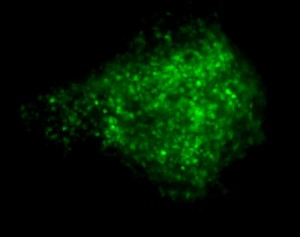Efficient generation of osteoblasts from pluripotent stem cells by using four small molecules Stepwise induction via mesoderm under serum-free conditions

Conventional strategies for generating cells or tissues of interest from pluripotent stem cells (PSCs, cells that are able to develop into every cell type in the body and proliferate almost indefinitely) bring concerns over safety and cost, which are caused by: (1) the use of reagents containing undefined factors, e.g., fetal bovine serum, in culture; (2) the formation of embryoid bodies (EBs, cell clusters formed by suspension culture of PSCs) that could possibly differentiate into unwanted tissues; and (3) the use of gene introductions or recombinant proteins as tissue-inducing factors. From this point of view, an ideal approach is the differentiation of PSCs into a certain tissue under defined conditions, in which unwanted differentiation is suppressed, using small molecules that have advantages in cost and stability.

© 2014 Kosuke Kanke & Shinsuke Ohba.
The present strategy efficiently generates osteoblast-like cells (green) from mouse ES cells that are engineered to express green fluorescent protein (GFP) upon osteoblast differentiation.
Dr. Kosuke Kanke (The University of Tokyo Graduate School of Medicine), Project Associate Professor Shinsuke Ohba, and Professor Yuichi Tei/Ung-il Chung (Department of Bioengineering, The University of Tokyo Graduate School of Engineering) have developed an efficient protocol for the differentiation of PSCs into bone-forming osteoblasts via mesoderm formation using just four small molecules under defined conditions. The protocol, which utilizes known components such as small molecules and suppresses unwanted differentiation of PSCs, is able to overcome the concerns described above.
The protocol offers a tool for in vitro mechanistic studies of osteoblast development, screening for bone augmentation drugs, pathological studies of bone diseases, and stem cell-based therapies for massive bone defects.
Paper
Kosuke Kanke, Hideki Masaki, Taku Saito, Yuske Komiyama, Hironori Hojo, Hiromitsu Nakauchi, Alexander C. Lichtler, Tsuyoshi Takato, Ung-il Chung, and Shinsuke Ohba,
“Stepwise differentiation of pluripotent stem cells into osteoblasts using four small molecules under serum-free and feeder-free conditions”,
Stem Cell Reports Online Edition: 2014/5/22, doi: 10.1016/j.stemcr.2014.04.016.
Article link
Links
Graduate School of Engineering
Department of Bioengineering, Graduate Schools of Engineering
Ohba-Yano-Chung/Tei Laboratory, Department of Bioengineering, Graduate Schools of Engineering







